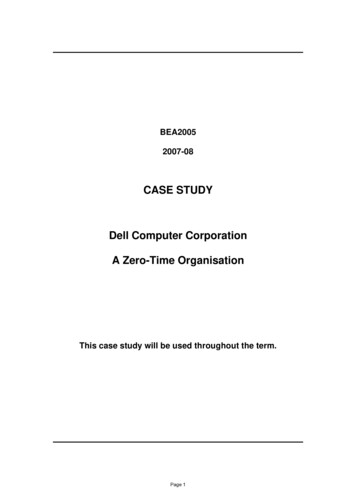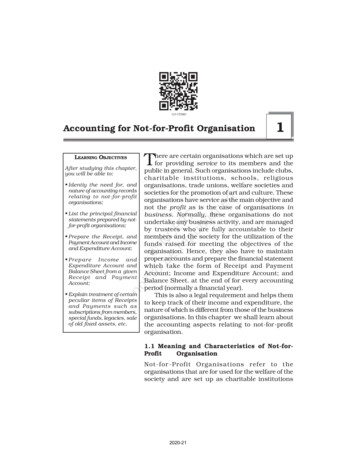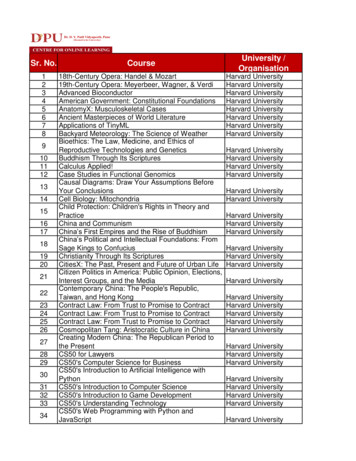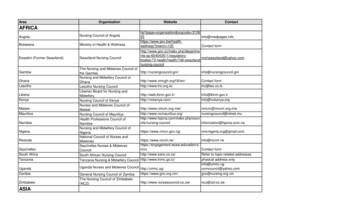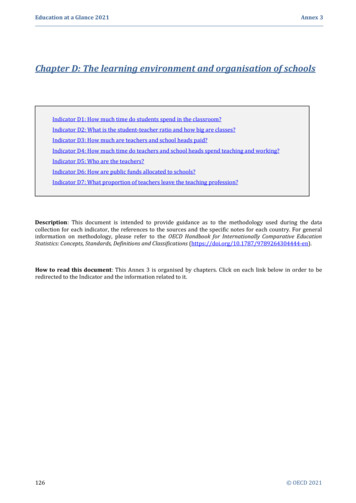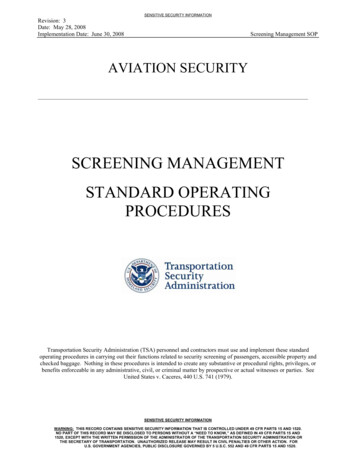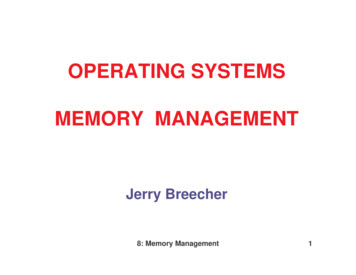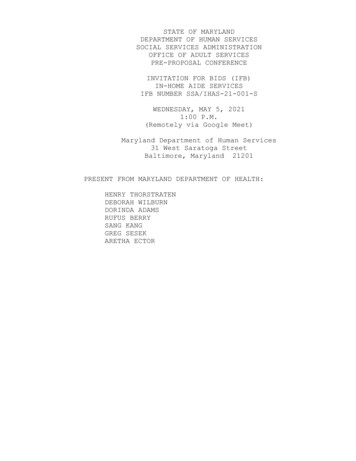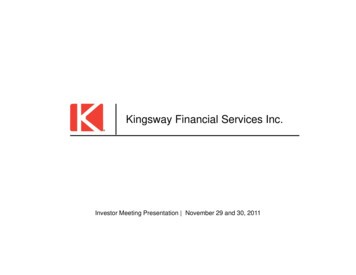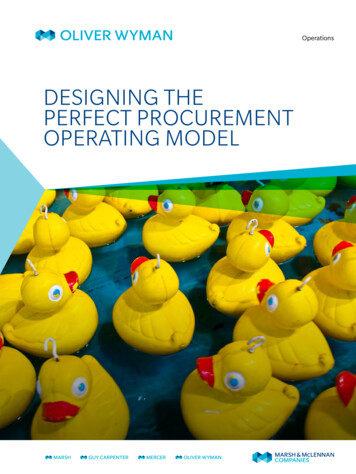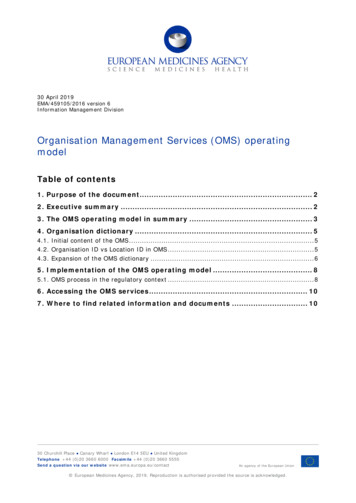
Transcription
30 April 2019EMA/459105/2016 version 6Information Management DivisionOrganisation Management Services (OMS) operatingmodelTable of contents1. Purpose of the document. 22. Executive summary . 23. The OMS operating model in summary . 34. Organisation dictionary . 54.1. Initial content of the OMS . 54.2. Organisation ID vs Location ID in OMS . 54.3. Expansion of the OMS dictionary . 65. Implementation of the OMS operating model . 85.1. OMS process in the regulatory context . 86. Accessing the OMS services . 107. Where to find related information and documents . 1030 Churchill Place Canary Wharf London E14 5EU United KingdomTelephone 44 (0)20 3660 6000 Facsimile 44 (0)20 3660 5555Send a question via our website www.ema.europa.eu/contactAn agency of the European Union European Medicines Agency, 2019. Reproduction is authorised provided the source is acknowledged.
1. Purpose of the documentThis document is intended to provide both guidance and information for stakeholders who aresupporting the implementation of the SPOR programme and for all stakeholders who will be using RMSdata management services. The information applies to both human and veterinary stakeholders;however, there may be different impacts experienced by NCAs and industry stakeholders.This document is reviewed periodically for accuracy.2. Executive summaryThe use of pharmaceutical and regulatory data can vary between organisations. The data may bestored in different formats using different database systems, applications, or data models. As a result,the same concept may be represented in a variety of different ways. For example, in the context oforganisation data, the same organisation name can be entered differently into various databases orapplications, e.g. “Middle Trade Group Limited” could be entered as “MTG Limited” or “MTG Ltd”. Theconsequence is that data is not consistent and cannot easily be reused.Organisations Management Services (OMS) is part of the phased implementation of theSPOR programme. The goal of SPOR is to deliver services that will centralise the management ofpharmaceutical and regulatory data for Substances, Products, Organisations, and Referentials(SPOR master data) and enable a consistent basis for reuse by EMA, NCAs and industry. Benefits ofSPOR data are expected to be realised incrementally as all phases of SPOR are delivered, and differentbusiness processes use the data.The key to achieving the goal of SPOR is the OMS operating model. It provides a sharedunderstanding of the OMS services by allowing visualisation of the services from a variety ofstakeholder perspectives as each significant element of OMS is represented. People, process andfunctional capabilities are the key underlining components ensuring successful delivery of theservice.The scope of OMS services includes data content, new process, functional capabilities and a team ofData Stewards: central repository and provider of organisation master data; SPOR web portal 1 and an application programming interface (API) through which data can beaccessed; a new process to register and update organisation data; EMA Data Stewards to manage data, applying consistent data quality rules and providing supportto stakeholders.The use of OMS will become mandatory, although the roll-out will be staggered when a givenregulatory business process begins to be supported by OMS data. More detailed information will beprovided in advance (by the relevant business owner) of any process changes including transitiontimelines. The mandating may vary between Human and Veterinary stakeholders depending on theimplementation timescales and business processes using the OMS data.OMS is already integrated with Electronic Application Forms (eAF) and supplying organisation masterdata to MAA Human, MAA Vet, Renewal and Variation application forms (use of OMS is not mandated1SPOR portal is compatible with web browsers Internet Explorer (version 10 and above) and Chrome (version 58 and above).Organisation Management Services (OMS) operating modelEMA/459105/2016Page 2/10
yet). IRIS platform to support orphan designation procedures (see here for more information) andEudraVigilance user registration process also started to make use of organisation master data.In future OMS data is expected to support regulatory submissions in Telematics systems such as; theCommon European Submission Portal (CESP), CT portal and Art.57/xEVMPD.The use of OMS data is also envisaged by the CTS system (Communication and Tracking System)which is used by the National Competent Authorities (NCAs) involved in the licensing of human andveterinary medicinal products via the mutual recognition and decentralised procedures.3. The OMS operating model in summaryIn the OMS operating model, the stakeholders, new process and functional capabilities are the keycomponents to ensure delivery of the service. This document describes the range of services availablefor stakeholders to use, the process to register organisation data or request data updates. It alsooutlines stakeholder interactions and identifies roles. The high-level concept of the OMS OperatingModel is shown in Figure 1 below.Figure 1. The OMS operating model.OMS provides a single source of validated organisation data that can be used as a reference and insupport of EU regulatory activities. In simple terms, OMS is a list of organisations with associatedphysical locations also referred to as the OMS dictionary (Figure 2). OMS data is master data and notregulatory data, and as such it represents the real world as much as possible. When the OMS data isused in the context of a regulatory activity or procedure, e.g. within a marketing authorisationapplication procedure, it becomes regulatory data.If the organisation’s name or any of its location-address related data changes, then it can be updatedin OMS separately from any regulatory procedure. EMA does not wait for the medicinal productinformation to be updated before the organisation/location data is updated in OMS.Organisation Management Services (OMS) operating modelEMA/459105/2016Page 3/10
Figure 2. An example of a list of organisations from the OMS dictionary.The initial content of OMS contained the data set below (see section 4.3 for information on how thecontent will expand): Marketing Authorisation Holders (MAHs): Human (H) Veterinary (V) Centrally AuthorisedProducts (CAPs) and Human (H) Nationally Authorised Products (NAPs); Marketing Authorisation Applicants (MAAs): (H V) CAPs; Maximum Residue Limit (MRL) applicants (V); Regulatory Authorities.Users, such as industry stakeholders, NCAs, EMA and other parties, can access the organisation masterdata through the OMS web portal, or through the Application Programming Interface (API). They canuse the dictionary of organisations for regulatory application submissions and other regulatoryactivities.In the context of a regulatory procedure (which uses the OMS data) industry stakeholders may need toregister organisation data or request the update of existing data in OMS (submit a “ChangeRequest”) before submitting a regulatory application to the relevant NCA or EMA. The RegulatoryAuthority will receive the application and process it without the need to validate the correctness of theorganisation data against OMS as long as the organisation data is from OMS.NCAs can also use the OMS data as a reference for the validation of their organisation data in supportof their regulatory procedures such as inspections. There may be cases when an NCA may requestregistration or the update of organisation data in OMS (e.g. to prepare for an inspection). Anyregistered SPOR user can submit an OMS change request. A change request can be submittedfor the organisation with which they are associated as well as any other organisation, although eachrequest will require supporting documentation/information. EMA Data Stewards will validate andprocess all requests. Except for minor changes or administrative changes 2, the change request shouldbe supported by the relevant documentation3 to be approved.OMS, supported by “Informatica Address Doctor service”, provides an address verification service.This service uses reference address data from national postal services. The verification of the addressby “Address Doctor” is also used to confirm the acceptability of the address data provided in eachchange request.2Minor correction examples: typos in organisation name or location address, addition/correction of telephone and/or emailaddress, to report a duplicate organisation, location (EN and/or non-EN address).3See change request validation in OMS document for the detailed guidance.Organisation Management Services (OMS) operating modelEMA/459105/2016Page 4/10
4. Organisation dictionary4.1. Initial content of the OMSThe initial content of the OMS dictionary originates from the Telematics systems, i.e. xEVMPD – Article57, EudraGMDP and other 3 EMA corporate systems. The IDs stored in the source systems have alsobeen loaded into OMS and thus mapped as cross-reference IDs against each organisation/locationrecord mastered in the OMS.The data mastering process is managed by EMA Data Stewards who follow a set of business rules anda data quality standard 4 to cleanse, standardise and consolidate the data before its publication in theOMS dictionary.Figure 3. Data sources for the initial content of the OMS dictionary.The OMS data is mastered with unique IDs (Organisation ID and Location ID see section 4.2) andmapped 5 to records taken from source systems. The structured data supports the implementation ofISO IDMP standard 11615 for medicinal product identification and ISO 11238 for substanceidentification 6.In OMS there is no difference between an organisation created in the context of a human medicinalproduct and a veterinary medicinal product. OMS does not define which role(s) the organisationperform(s) since it depends on the context in which the data is used. An organisation can act as anMAH (Marketing Authorisation Holder) in the context of one medicinal product but as a Sponsor orManufacturer for another medicinal product. Organisations are categorised in OMS by type: ‘Industry’,‘Regulatory Authority’, ‘Educational Institution’, ‘Healthcare’, etc. or by size: SME as ‘Micro’, ‘Small’, or‘Medium’.4.2. Organisation ID vs Location ID in OMSThe Organisation IDs stored in the source systems have been loaded to OMS and thus mapped as across-reference ID against each organisation/location record mastered in OMS. Organisation andlocation can be defined as follows:Organisation - An organisation is a legal entity (e.g. organisation name). Organisations are countryspecific. All locations under one organisation must be located in the same country (or must belong to4Data quality Standard in OMS document is available on the OMS Web portalMapped – matched data elements between two (or more) distinct sets of dataAlthough these standards apply to human medicinal product only SPOR services will also support veterinary regulatoryactivities.56Organisation Management Services (OMS) operating modelEMA/459105/2016Page 5/10
the same jurisdiction). For OMS, organisations registered in different jurisdictions are treated asdifferent legal entities, and as such, each will have a unique ID. OMS does not currently manage thehierarchical relationships between organisations.Location – This is the physical location (address) of an organisation. A location can only be associatedwith a single organisation at any one time. Each active organisation must have at least one activelocation associated with it. An address can be present in multiple locations as long as they areassociated with different organisations. Each location will have a unique location ID. This location IDremains the same if a location is moved from one organisation to another organisation.Figure 4. Organisation ID vs. Location ID in OMS.4.3. Expansion of the OMS dictionaryThe content of the OMS will be expanded incrementally, and EMA will inform stakeholders about thetiming of the release of new organisation data in the dictionary and specify when users can startsubmitting change requests for the organisation data that has been added (Figure 5).Figure 5. Data sets to be included in the OMS dictionary.Data sets to be mastered and included in theStatus of dataOMS dictionarymasteringData set 1:Completed Submission of CRsUsers can submit changerequests.Marketing Authorisation Holders (MAHs):Human (H) Veterinary (V) CentrallyAuthorised Products (CAPs) and Human (H)Nationally Authorised Products (NAPs); Marketing Authorisation Applicants (MAAs):(H V) CAPs; Maximum Residue Limit (MRL) applicants(Veterinary); EU National Competent Authorities; Regulatory Authorities.Data set 2:Organisation Management Services (OMS) operating modelEMA/459105/2016CompletedUsers can submit changePage 6/10
Data sets to be mastered and included in theStatus of dataOMS dictionarymastering EV (EudraVigilance) organisations to support EVuser management.Data set 3: requests.CompletedUsers can submit changerequests.Orphan Designation organisations (supportingIRIS platform).Data set 4:Submission of CRsCompletedUsers are NOT required tostart submitting changeSponsors (H) CAPs and NAPs.requests (CR) yet.Data set 5: Mastering ofTiming of the submission ofManufacturers (H V) CAPs;manufacturers isCRs to be communicated inManufacturers (H V) NAPs.ongoing. TargetQ4 2019.to complete - bythe end of Q42019 (alignedwith CESPdataset module).Data set 6: CompletedUsers can submit changerequests.Parallel distributors (supporting IRIS platform).Data set 8:Users can submit changerequests.Veterinary MAHs & MAAs for NAPs.Data set 7: CompletedNot startedTiming to be communicated.Organisations supporting the Clinical Trialapplication proceduresNote: The exact content of the organisations to beadded will be communicated. The organisations willbe added through the OMS change requestprocess.Additional Organisation data will be published in the future, and the prioritisation of its inclusion in thedictionary will be defined at a later stage. This will include: Contract Research Organisations (CROs); Clinical trials sites; Academia; Hospitals; Wholesale distributors; MAA/MAH and manufacturers in the context of herbal and homeopathic medicinal products orcompassionate use medicinal products.Organisation Management Services (OMS) operating modelEMA/459105/2016Page 7/10
New sources for organisation data, to be incorporated in the OMS dictionary, may be identified in thefuture.5. Implementation of the OMS operating modelThe use of OMS data can be mandated by a given regulatory process when it is integrated with OMS.The application owners supporting the process using OMS data will have to establish the approach ofmandating the use of OMS data. The SPOR programme has been consulting stakeholders on thebenefits of using the master data, and these consultations have resulted in a number of integrationinitiatives.In December 2017, OMS was integrated with eAF and started supplying organisation master data tothe electronic application forms. Use of OMS in eAF is not mandatory yet. However, applicants areencouraged to use OMS data (as opposed to the free text) when completing the application forms tobecome more familiar with it. If the organisation is not in the eAF drop-down list, it should berequested through the OMS portal before the application is submitted to the relevant regulatoryauthority (refer to Figure 5 to see for which data set stakeholders can start submitting OMS CRs).A business process that mandated the use of OMS data is IRIS platform to support the end-to-endorphan designation procedures. Also, the new EV user management solution mandated the use oforganisation data from OMS.In future OMS data is expected to support regulatory submissions in Telematics systems such as theCommon European Submission Portal (CESP), CT portal and product data submissions inArt.57/xEVMPD. The use of OMS data is also envisaged by the CTS system (Communication andTracking System) which is used by the National Competent Authorities (NCAs) involved in the licensingof human and veterinary medicinal products via the mutual recognition and decentralised procedures.There may be a transition period before the use of OMS data services becomes mandatory in any givenregulatory process. More information will be provided by the relevant business process owner in duecourse to explain the relevant process changes and timings.5.1. OMS process in the regulatory contextAs described above, EMA manages the process for industry stakeholders and other parties to registerorganisation data or request update of existing data through the OMS portal. In the context ofregulatory procedures, this step is required before submitting a regulatory application to the relevantNCA or EMA and also referred to as “pre-registration” of an organisation/organisation update.OMS users will be able to search for organisations and locations and view details oforganisations/locations. A search is a starting point to request changes or additions to the organisationdata (submit a change request). The following options are available: the user is not able to find the organisation, defined by name in a given country, so that they canrequest the creation of a new organisation; if the organisation is found, but the required location is not found, the requestor will need tosubmit a request to add a new location to the existing organisation; alternatively, a user locates an existing organisation and location but determines that either theorganisation or both the organisation and location need to be changed.Organisation Management Services (OMS) operating modelEMA/459105/2016Page 8/10
Any registered SPOR user can submit an OMS change request. The OMS portal will not prevent a userfrom submitting a request for an organisation to which they are associated as well as any otherorganisation. Each request will require supporting documentation/information which will be validatedby EMA Data Stewards, who process all change requests. EMA Data Stewards will undertake dataquality checks upon pre-registration of a new organisation or receipt of a change request of existingorganisation data.OMS has a built-in address verification service for all EEA countries called “Informatica AddressDoctor”. This service uses reference address data from the main postal service in each country andverifies the address to confirm the validity of the address data provided in the change request. In thecase of any inconsistencies between the EMA Data Stewards and requestors, these will be reviewedand resolved individually.Once an organisation is registered, it is available in the OMS portal and supplied to the consumingsystem (e.g. eAF). At that point, the applicant can continue with the completion and submission of theapplication form. The relevant authority, NCA or EMA will receive the application and can process itwithout needing to validate the organisation data against OMS, as long as the organisation datafeeding through to the application form is from a list that is available in OMS as that time.In case of eAF, the regulatory authority receiving the application will know the data comes from OMSas
OMS, supported by “Informatica Address Doctor service”, provides an address verification service. This service uses reference address data from national postal services . The verification of the address by “Address Doc
